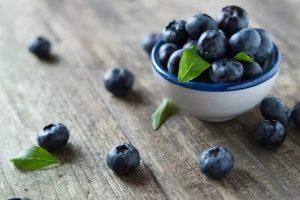Written by Taylor Woosley, Staff Writer. 1-week intervention of daily blueberry consumption of whole blueberry (160 g) or freeze-dried blueberry powder (20 g) in healthy adults improved NO2 levels by 68.66% and 4.34%, respectively compared to the baseline (p=0.148).
 Cardiovascular disease (CVD) is the leading cause of death in both men and women in the United States1. CVD has a complex pathogenesis and can manifest as coronary artery disease, heart failure, cerebrovascular disease and peripheral artery disease2. Traditional risk factors include hypertension, dyslipidemia, obesity, and diabetes3. Furthermore, modifiable risk factors, such as smoking, physical inactivity, excess alcohol consumption, and poor diet also play a large role in CVD occurrence4.
Cardiovascular disease (CVD) is the leading cause of death in both men and women in the United States1. CVD has a complex pathogenesis and can manifest as coronary artery disease, heart failure, cerebrovascular disease and peripheral artery disease2. Traditional risk factors include hypertension, dyslipidemia, obesity, and diabetes3. Furthermore, modifiable risk factors, such as smoking, physical inactivity, excess alcohol consumption, and poor diet also play a large role in CVD occurrence4.
Blueberry intake has been previously shown to have cardioprotective benefits due to their constituent polyphenols5. Blueberries contain the polyphenol anthocyanin, a bioflavonoid that has free radical scavenging and antioxidant properties6. Furthermore, the anti-inflammatory effects of blueberries target underlying chronic low-grade inflammation that is central to cardiometabolic pathophysiology7.
Wang Y. et al. conducted a randomized, controlled, single-blinded, counter-balanced-cross-over study to evaluate the efficacy of daily consumption of whole blueberry and freeze-dried blueberry powder on cardiovascular health. Subjects (n=37, aged 18-60 years) were included if they had no relevant pre-existing medical conditions, with a healthy BMI, and no habitual supplement consumption. Participants were given one of three treatments: the 160g of fresh whole blueberry group, the 20 g of freeze-dried blueberry powder group or a control capsule with plant-derived fiber microcrystalline cellulose. Subjects were given a treatment for 1 week and then had a 1-week washout period, with each treatment given to participants in a random sequence.
Blood samples were collected to measure concentrations of glucose, lipid profile, and the nitric oxide metabolite (NO2). Anthropometric measurements were recorded at the screening session. Cardiovascular health was measured through assessing systolic and diastolic blood pressure, monitoring the cardiac rhythm, and pulse wave velocity of the carotid and radial artery. Participants were assessed at 7 visits throughout the study, including the baseline visit and screening session, followed by post-intervention visits. At the 2nd, 4th and 6th visit, participants provided a urine sample and a 1-day food diary questionnaire. Statistical analysis included observing the efficacy of visit orders, differences of sex, and the comparison of all three treatments. The difference in subjects’ nutritional intake across visits was analyzed using a paired t-test.
Results of the study show that 7-day chronic intervention of both whole blueberry or freeze-dried powder did not significantly influence measures of blood pressure, glucose, endothelial function, lipid profiles or nitrite levels. However, plasma NO2 levels were improved by 68.66% and 4.34% following whole blueberry and blueberry powder supplementation, respectively, compared to the baseline. The control group reported a decrease (-9.10%) which was not statistically significant (p=0.148).
Study findings suggest that blueberry consumption plays a role in improving NO2 levels which has been shown to benefit peripheral and cerebral peripheral blood flow. Future studies should feature a longer intervention time to observe any potential positive changes in blood pressure, lipid, and glucose levels. Study limitations include the use of healthy subjects with normal ranges of glucose, lipid, and vascular markers and the short duration of the study intervention.
Source: Wang, Yueyue, Jose Lara Gallegos, Crystal Haskell-Ramsay, and John K. Lodge. “Effects of blueberry consumption on cardiovascular health in healthy adults: a cross-over randomised controlled trial.” Nutrients 14, no. 13 (2022): 2562.
© 2022 by the authors. Li‐ censee MDPI, Basel, Switzerland. This article is an open access article distributed under the terms and con‐ ditions of the Creative Commons At‐ tribution (CC BY) license (https://cre‐ ativecommons.org/licenses/by/4.0/).
Click here to read the full text study.
Posted September 1, 2022.
Taylor Woosley studied biology at Purdue University before becoming a 2016 graduate of Columbia College Chicago with a major in Writing. She currently resides in Glen Ellyn, IL.
References:
- Tran DT, Silvestri-Elmore A, Sojobi A. Lifestyle Choices and Risk of Developing Cardiovascular Disease in College Students. Int J Exerc Sci. 2022;15(2):808-819.
- Blann AD, Brown JE, Heitmar R. Angiogenesis, Metabolism, Endothelial and Platelet Markers in Diabetes and Cardiovascular Disease. Br J Biomed Sci. 2022;79:10313. doi:10.3389/bjbs.2022.10313
- Liew SM, Chowdhury EK, Ernst ME, et al. Prescribed opioid use is associated with adverse cardiovascular outcomes in community‐dwelling older persons. ESC heart failure. 2022;
- Xiao W, Wumaer A, Maimaitiwusiman Z, Liu J, Xuekelati S, Wang H. Heat maps of cardiovascular disease risk factor clustering among community-dwelling older people in Xinjiang: a cross-sectional study. BMJ Open. Aug 18 2022;12(8):e058400. doi:10.1136/bmjopen-2021-058400
- Curtis PJ, Berends L, van der Velpen V, et al. Blueberry anthocyanin intake attenuates the postprandial cardiometabolic effect of an energy-dense food challenge: Results from a double blind, randomized controlled trial in metabolic syndrome participants. Clinical nutrition (Edinburgh, Scotland). Jan 2022;41(1):165-176. doi:10.1016/j.clnu.2021.11.030
- Wang C, Wang K, Li P. Blueberry anthocyanins extract attenuated diabetic retinopathy by inhibiting endoplasmic reticulum stress via the miR-182/OGG1 axis. J Pharmacol Sci. Sep 2022;150(1):31-40. doi:10.1016/j.jphs.2022.06.004
- Sinclair J, Shadwell G, Dillon S, Allan R, Butters B, Bottoms L. Effects of Montmorency Tart Cherry and Blueberry Juice on Cardiometabolic Outcomes in Healthy Individuals: Protocol for a 3-Arm Placebo Randomized Controlled Trial. Int J Environ Res Public Health. Sep 16 2021;18(18)doi:10.3390/ijerph18189759
